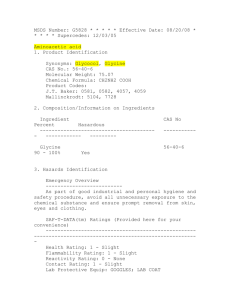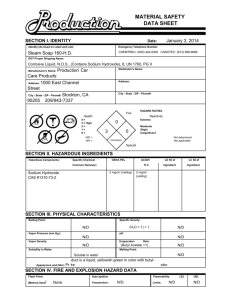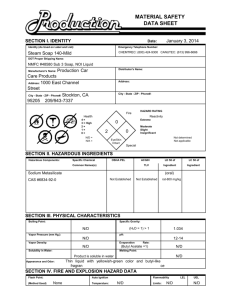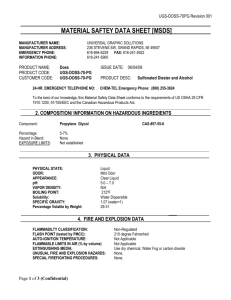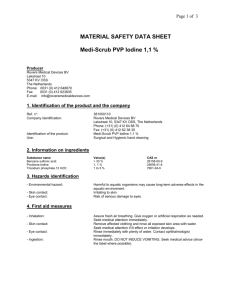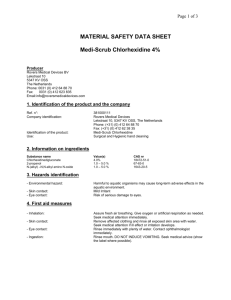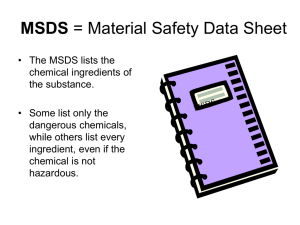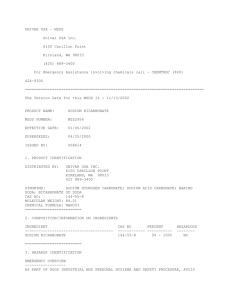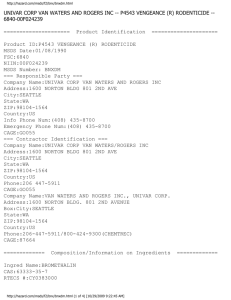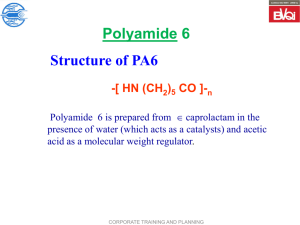POLYAMIDE 6
advertisement
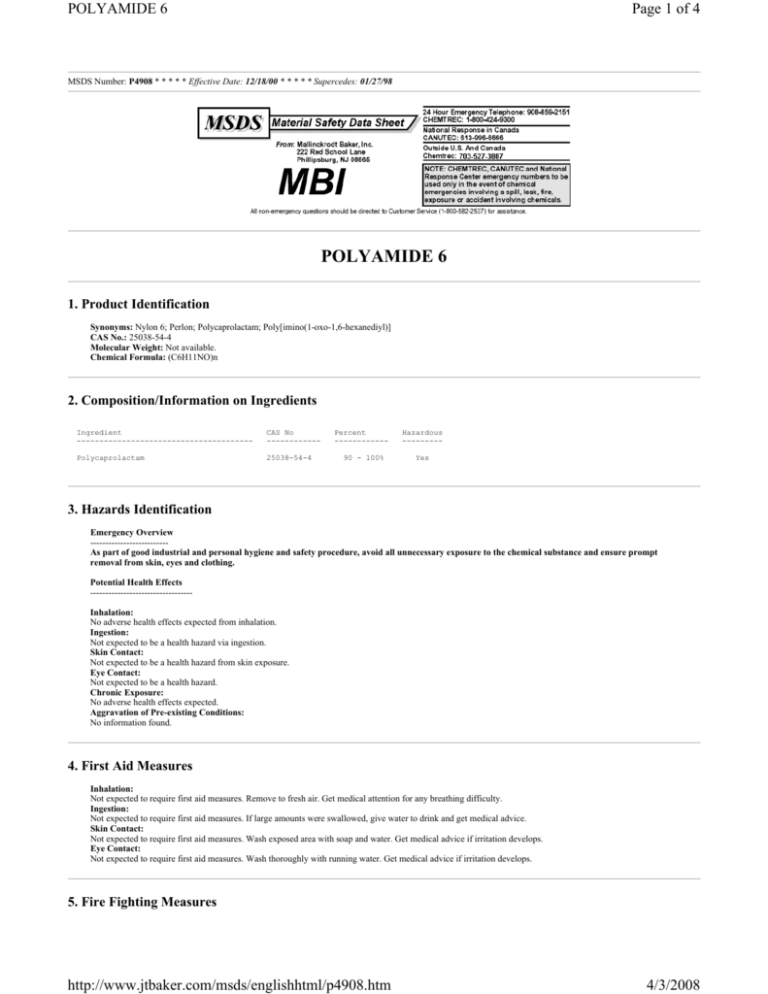
POLYAMIDE 6 Page 1 of 4 MSDS Number: P4908 * * * * * Effective Date: 12/18/00 * * * * * Supercedes: 01/27/98 POLYAMIDE 6 1. Product Identification Synonyms: Nylon 6; Perlon; Polycaprolactam; Poly[imino(1-oxo-1,6-hexanediyl)] CAS No.: 25038-54-4 Molecular Weight: Not available. Chemical Formula: (C6H11NO)n 2. Composition/Information on Ingredients Ingredient --------------------------------------- CAS No ------------ Polycaprolactam 25038-54-4 Percent -----------90 - 100% Hazardous --------Yes 3. Hazards Identification Emergency Overview -------------------------As part of good industrial and personal hygiene and safety procedure, avoid all unnecessary exposure to the chemical substance and ensure prompt removal from skin, eyes and clothing. Potential Health Effects ---------------------------------Inhalation: No adverse health effects expected from inhalation. Ingestion: Not expected to be a health hazard via ingestion. Skin Contact: Not expected to be a health hazard from skin exposure. Eye Contact: Not expected to be a health hazard. Chronic Exposure: No adverse health effects expected. Aggravation of Pre-existing Conditions: No information found. 4. First Aid Measures Inhalation: Not expected to require first aid measures. Remove to fresh air. Get medical attention for any breathing difficulty. Ingestion: Not expected to require first aid measures. If large amounts were swallowed, give water to drink and get medical advice. Skin Contact: Not expected to require first aid measures. Wash exposed area with soap and water. Get medical advice if irritation develops. Eye Contact: Not expected to require first aid measures. Wash thoroughly with running water. Get medical advice if irritation develops. 5. Fire Fighting Measures http://www.jtbaker.com/msds/englishhtml/p4908.htm 4/3/2008 POLYAMIDE 6 Page 2 of 4 Fire: Not considered to be a fire hazard. Liberates toxic gases when involved in a fire. Explosion: Not considered to be an explosion hazard. Fire Extinguishing Media: Use any means suitable for extinguishing surrounding fire. Special Information: In the event of a fire, wear full protective clothing and NIOSH-approved self-contained breathing apparatus with full facepiece operated in the pressure demand or other positive pressure mode. 6. Accidental Release Measures Wear appropriate personal protective equipment as specified in Section 8. Spills: Sweep, scoop or pick up and containerize for reclamation or disposal. 7. Handling and Storage Keep in a tightly closed container, stored in a cool, dry, ventilated area. Protect against physical damage. Containers of this material may be hazardous when empty since they retain product residues (dust, solids); observe all warnings and precautions listed for the product. 8. Exposure Controls/Personal Protection Airborne Exposure Limits: None established. Ventilation System: In general, dilution ventilation is a satisfactory health hazard control for this substance. However, if conditions of use create discomfort to the worker, a local exhaust system should be considered. Personal Respirators (NIOSH Approved): Not expected to require personal respirator usage. Skin Protection: Not expected to require skin protection. Eye Protection: Use chemical safety goggles. Maintain eye wash fountain and quick-drench facilities in work area. 9. Physical and Chemical Properties Appearance: Crystalline powder. Odor: No information found. Solubility: Negligible (< 0.1%) Specific Gravity: 1.14 pH: No information found. % Volatiles by volume @ 21C (70F): 0 Boiling Point: No information found. Melting Point: 223C (433F) Vapor Density (Air=1): Not applicable. Vapor Pressure (mm Hg): Not applicable. Evaporation Rate (BuAc=1): No information found. 10. Stability and Reactivity Stability: Stable under ordinary conditions of use and storage. Hazardous Decomposition Products: Thermal decomposition products may include carbon oxides, nitrogen oxides, and hydrogen cyanide. Hazardous Polymerization: Will not occur. Incompatibilities: Strong oxidants, acids. Resistant to most organic chemicals, but dissolved by phenol, cresol, and strong acids. Immune to microbiological attack. Conditions to Avoid: Heat, flames, ignition sources and incompatibles. http://www.jtbaker.com/msds/englishhtml/p4908.htm 4/3/2008 POLYAMIDE 6 Page 3 of 4 11. Toxicological Information No LD50/LC50 information found relating to normal routes of occupational exposure. Investigated as a tumorigen. --------\Cancer Lists\--------------------------------------------------------NTP Carcinogen--Ingredient Known Anticipated IARC Category -------------------------------------------------------------Polycaprolactam (25038-54-4) No No 3 12. Ecological Information Environmental Fate: No information found. Environmental Toxicity: No information found. 13. Disposal Considerations Whatever cannot be saved for recovery or recycling should be managed in an appropriate and approved waste disposal facility. Processing, use or contamination of this product may change the waste management options. State and local disposal regulations may differ from federal disposal regulations. Dispose of container and unused contents in accordance with federal, state and local requirements. 14. Transport Information Not regulated. 15. Regulatory Information --------\Chemical Inventory Status - Part 1\--------------------------------Ingredient TSCA EC Japan Australia ----------------------------------------------- ---- --- ----- --------Polycaprolactam (25038-54-4) Yes No Yes Yes --------\Chemical Inventory Status - Part 2\----------------------------------Canada-Ingredient Korea DSL NDSL Phil. ----------------------------------------------- ----- ------ ----Polycaprolactam (25038-54-4) Yes Yes No Yes --------\Federal, State & International Regulations - Part 1\----------------SARA 302------SARA 313-----Ingredient RQ TPQ List Chemical Catg. ----------------------------------------- ---------- -------------Polycaprolactam (25038-54-4) No No No No --------\Federal, State & International Regulations - Part 2\----------------RCRA-TSCAIngredient CERCLA 261.33 8(d) ----------------------------------------- ---------------Polycaprolactam (25038-54-4) No No No Chemical Weapons Convention: No TSCA 12(b): No SARA 311/312: Acute: No Chronic: No Fire: No Reactivity: No (Pure / Solid) CDTA: No Pressure: No Australian Hazchem Code: None allocated. Poison Schedule: None allocated. WHMIS: This MSDS has been prepared according to the hazard criteria of the Controlled Products Regulations (CPR) and the MSDS contains all of the information required by the CPR. 16. Other Information NFPA Ratings: Health: 0 Flammability: 0 Reactivity: 0 Label Hazard Warning: As part of good industrial and personal hygiene and safety procedure, avoid all unnecessary exposure to the chemical substance and ensure prompt removal from skin, eyes and clothing. Label Precautions: None. Label First Aid: Not applicable. http://www.jtbaker.com/msds/englishhtml/p4908.htm 4/3/2008 POLYAMIDE 6 Page 4 of 4 Product Use: Laboratory Reagent. Revision Information: No changes. Disclaimer: ************************************************************************************************ Mallinckrodt Baker, Inc. provides the information contained herein in good faith but makes no representation as to its comprehensiveness or accuracy. This document is intended only as a guide to the appropriate precautionary handling of the material by a properly trained person using this product. Individuals receiving the information must exercise their independent judgment in determining its appropriateness for a particular purpose. MALLINCKRODT BAKER, INC. MAKES NO REPRESENTATIONS OR WARRANTIES, EITHER EXPRESS OR IMPLIED, INCLUDING WITHOUT LIMITATION ANY WARRANTIES OF MERCHANTABILITY, FITNESS FOR A PARTICULAR PURPOSE WITH RESPECT TO THE INFORMATION SET FORTH HEREIN OR THE PRODUCT TO WHICH THE INFORMATION REFERS. ACCORDINGLY, MALLINCKRODT BAKER, INC. WILL NOT BE RESPONSIBLE FOR DAMAGES RESULTING FROM USE OF OR RELIANCE UPON THIS INFORMATION. ************************************************************************************************ Prepared by: Environmental Health & Safety Phone Number: (314) 654-1600 (U.S.A.) http://www.jtbaker.com/msds/englishhtml/p4908.htm 4/3/2008

